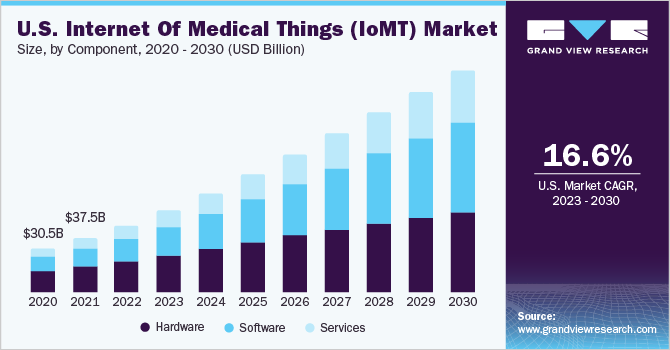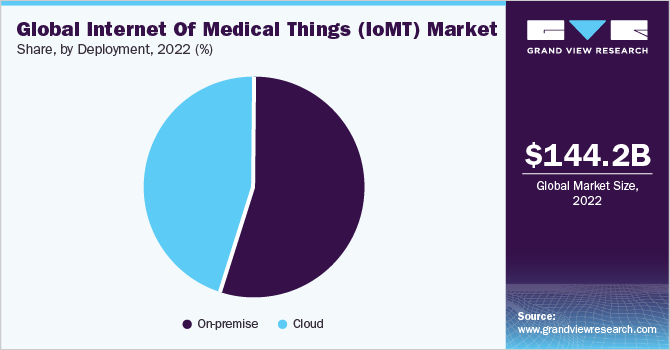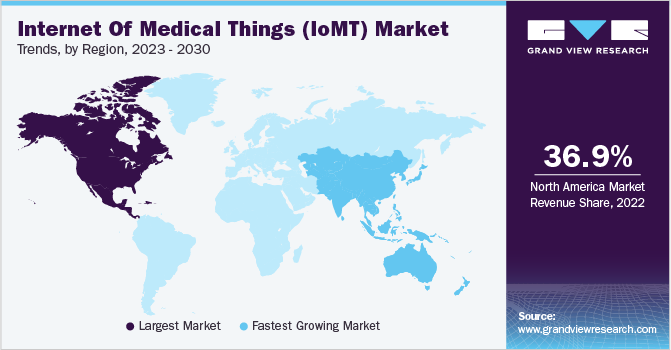
Internet of Medical Things (IoMT) Market Size, Share & Trends Analysis Report By End-use (Hospitals, Clinics), By Component (Software, Services), By Deployment (Cloud, On-premise), By Application, By Region, And Segment Forecasts, 2023 - 2030
- Report ID: GVR-4-68040-109-0
- Number of Pages: 150
- Format: Electronic (PDF)
- Historical Range: 2018 - 2021
- Industry:Technology
Report Overview
The globalinternet of medical things (IoMT) market sizewas estimated atUSD 144.23 billion in 2022and is expected to grow at a compound annual growth rate (CAGR) of 20.4% from 2023 to 2030.The advancements in sensor technology, miniaturization, and connectivity solutions are enabling the development of more sophisticated and affordable medical devices, making IoMT more accessible to healthcare providers and patients, which is driving market growth. Furthermore, the global rise in the aging population and increasing prevalence of chronic diseases created a greater demand for remote monitoring and healthcare management solutions, which is expected to drive the market growth over the forecast period. In addition,the implementation ofradio-frequency identification(RFID) tags in IoMT plays a fundamental role in managing drug availability problems and supply costs.

Recognizing the significance of this technology, the FDA has issued guidelines for RFID implementation in drugsupply chain management. By leveraging IoMT and RFID, pharmaceutical companies can streamline their operations, optimize drug distribution, and enhance overall supply chain efficiency, which is anticipated to fuel the market demand over the forecast period. Furthermore, key players are continuously enhancing and improving their product portfolio and increasing their geographical presence. For instance, in September 2022, GE Healthcare Technologies Inc. launched Optima IGS320, an innovative AI-powered cath lab. This advanced technology enhances imaging precision, enabling intelligent & precise healthcare delivery.
With its social gantry movement feature, the system offers significant flexibility during surgeries, lightening the burden on doctors and enabling them to focus more effectively on patient care. The Optima IGS320 marks a significant advancement in the field of medical imaging, supporting medical professionals in delivering superior and accurate healthcare services. Such development by key players is expected to boost the market expansion over the forecast period. The COVID-19 pandemic led to the subsequent lockdown restrictions and temporarily forced manufacturing units and factories to remain shut, affecting the demand and supply chain worldwide and hampering numerous industries. However, the pandemic accelerated the adoption of telemedicine and remote patient monitoring solutions, which heavily rely on IoMT devices.
Healthcare providers turned to these technologies to maintain patient care while minimizing in-person interactions. Moreover, the ongoing innovation and development in the market are anticipated to propel its growth over the forecast period. In addition, the data collected withIoTdevices helps healthcare organizations analyze patient flow, resource utilization, and operational efficiency. This valuable information enables them to effectively evaluate staffing patterns, leading to optimized healthcare workforce composition, adequate staffing levels, and enhanced patient care delivery.Such technological advancements are expected to propel the IoMT industry growth over the forecast period.
Component Insights
The hardware component segment accounted for the largest market share of 47.3% in 2022. This is attributed to the increased usage of IoT-enabled medical equipment. Hardware components are designed to support various connectivity options, including Bluetooth, Wi-Fi, cellular, and low-power wide-area networks (LPWAN). This flexibility enables seamless data transmission to healthcare systems andmobile applications, which is expected to drive the segment growth over the forecast period. The segment is further divided into wearable devices, stationary devices, implantable devices, and others. The stationary devices segment held the largest market share in 2022.
This is due to the expansion of wireless communication technologies like Wi-Fi, Bluetooth, and LPWAN, which have improved connectivity options for stationary IoT devices. Thus, making it easier to integrate them into existing networks. The software component segment is expected to register the highest CAGR of 23.5% over the forecast period. This is owing to the use ofartificial intelligence(AI) and machine learning (ML) algorithms to analyze large volumes of patient data and provide valuable insights for personalized healthcare. In addition, the ongoing development and enhancement of software components for IoMT devices to support telemedicine and virtual care services, which include remote consultations and integrating video conferencing, are expected to drive the segment's growth.
The software component segment is further divided into device management, application management, cloud management,data analytics等等。设备管理段accounted for a significant share in 2022. This growth is attributed to the proliferation of connected medical devices, such as wearables, remote monitoring devices, and smart medical implants. With the growing number of devices, the need for efficient management, monitoring, and maintenance has also increased considerably, which is augmenting the segment growth.
Application Insights
Thetelemedicinesegment accounted for the largest revenue share of 31.1% in 2022 and is expected to continue the same trend over the forecast period. The growth of the segment is attributed to its ability to improve patient convenience, address healthcare access challenges, and provide cost-effective & efficient medical services, especially in underserved & remote areas. Furthermore, integrating IoMT technologies enhances telemedicine's effectiveness by enabling remote monitoring and real-time data exchange, which is expected to drive the segment growth during the forecast period.
住院病人监测段预计grow at the fastest CAGR of 22.1% over the forecast period. Inpatient monitoring helps identify declining health conditions promptly, allowing healthcare professionals to medicate early and prevent adverse outcomes. This timely intervention leads to improved patient outcomes and reduced hospital readmissions, which is expected to drive the inpatient monitoring segment growth during the forecast period.
End-use Insights
The hospitals segment accounted for the largest revenue share of over 31.6% in 2022. The growth is attributed to the rising prevalence of chronic diseases, the growing elderly population, and rising healthcare expenditure among consumers. The growing need for regular health checkups and increasing demand for smart technologies for tracking patients’ health conditions in hospitals and clinics are expected to boost the segment growth over the forecast period.
家庭护理部分预计将增长的迹象ificant CAGR of 20.9% over the forecast period. This growth is attributed to the increased preferences of consumers to get treatment for various diseases in the comfort of their homes. Increased disposable income, awareness regarding hospital-acquired infections, and consumer expenditure on health & wellness products and services are also among the key factors augmenting the segment’s growth.
Deployment Insights
The on-premise segment accounted for the largest market share of 55.3% in 2022. The on-premise deployment segment growth is attributed to its offering for healthcare providers to enhance control over their internet of medical things (IoMT) infrastructure. The ability to customize software solutions and seamlessly integrate with existing IT systems further drives the need for segment growth. This level of control becomes critical for organizations with specific operational requirements and workflows, adopting a conducive environment for growth and innovation in healthcare services. This, in turn, is expected to fuel the segment's growth over the forecast period.

The cloud-based deployment segment is expected to register the fastest growth rate of 21.1% over the forecast period. This growth is attributed to the numerous benefits offered, such as scalability and flexibility, which are driving the adoption of IoMT solutions by healthcare providers and organizations. In addition, healthcare organizations can easily expand or adjust their resources to meet changing demands as the number of connected medical devices and data volumes continues to increase. This adaptability is essential in providing efficient and effective healthcare services, which is driving the segment growth.
Regional Insights
The North America regional market captured the highest revenue share of 36.9% in 2022. This growth is attributed to the developed telecommunications, improved IT infrastructure, strong & established healthcare facilities, and increased penetration of the internet across the region. Furthermore, the increasing consumer expenditure on healthcare, higher disposable income, and a rising prevalence of diseases are contributing to a growing demand for healthcare products and services, which is driving the expansion of the regional market. The Asia Pacific region is expected to register a considerable CAGR of 23.6% over the forecast period.

The growth of the regional market is driven by the collaborations and partnerships of the key market players. For instance, in August 2022, GE Healthcare Technologies Inc., a global innovator in medical technology, diagnostics, and digital solutions, collaborated with Boston Scientific, a leading global medical device manufacturer. The aim of the partnership was to offer comprehensive interventional cardiac care solutions in India. By joining forces, the two companies seek to enhance patient access to treatment and improve heart care in the country, ultimately addressing the prevailing disease burden related to cardiac health. Such initiatives by key players are expected to fuel the market demand in the region.
Key Companies & Market Share Insights
The market is classified as highly competitive with the presence of several players. The key players operating in the industry are focusing on strategic alliances, product development, expansion, and mergers & acquisitions to remain competitive in the industry. For instance, in May 2023, Medtronic plc, a healthcare technology company, acquired EOFlow Co. Ltd., the manufacturer of EOPatch devices. With this acquisition, the company aims to complement its existing next-generation continuous glucose monitor (CGM) and Meal Detection Technology algorithm. The integration of EOFlow's technology is expected to enhance Medtronic's capacity to cater to a broader range of individuals with diabetes, offering diverse options for insulin delivery, regardless of their treatment stage or personal preferences. Such M&A activities are anticipated to augment the market growth over the forecast period. Some of the major players in the global internet of medical things (IoMT) market include:
Apple, Inc.
Boston Scientific Corporation
Biotronik SE & Co. KG
Cisco Systems, Inc.
General Electric Company
Honeywell International Inc.
IBM Corporation
Johnson & Johnson Services, Inc.
Koninklijke Philips N.V.
Lenovo Group Ltd.
Medtronic plc
Neurometrix, Inc.
Microsoft Corporation
SAP SE
- Siemens AG
Internet of Medical Things (IoMT) Market Report Scope
Report Attribute |
Details |
Market size value in 2023 |
USD 181.91 billion |
Revenue forecast in 2030 |
USD 668.07 billion |
Growth rate |
CAGR of 20.4% from 2023 to 2030 |
Base year for estimation |
2022 |
Historical data |
2018 - 2021 |
Forecast period |
2023 - 2030 |
Quantitative units |
Revenue in USD Million/Billion and CAGR from 2023 to 2030 |
Report coverage |
Revenue forecast, company ranking, competitive landscape, growth factors, and trends |
Segments covered |
Component, deployment, application, end-use, and region |
Regional scope |
North America; Europe; Asia Pacific; Latin America; and Middle East & Africa |
Country scope |
U.S.; Canada; Germany; UK; France; Italy; Spain; China; India; Japan; South Korea; Brazil; Mexico; South Africa; UAE |
Key companies profiled |
Apple, Inc.; Boston Scientific Corp.; Biotronik SE & Co. KG; Cisco Systems, Inc.; General Electric Company; Honeywell International Inc.; IBM Corp.; Johnson & Johnson Services, Inc.; Koninklijke Philips N.V.; Lenovo Group Ltd.; Medtronic plc; Neurometrix, Inc.; Microsoft Corp.; SAP SE; Siemens AG |
Customization scope |
Free report customization (equivalent to up to 8 analyst working days) with purchase. Addition or alteration to country, regional & segment scope |
Pricing and purchase options |
Avail customized purchase options to meet your exact research needs.Explore purchase options |
GlobalInternet of Medical Things (IoMT) Market ReportSegmentation
This report forecasts revenue growth at global, regional, and country levels and provides an analysis of the latest trends in each of the sub-segments from 2018 to 2030. For this study, Grand View Research has segmented the global internet of medical things (IoMT) market report on the basis of component, deployment, application, end-use, and region:
Component Outlook (Revenue, USD Million, 2018 - 2030)
Hardware
Wearable Devices
Stationary Devices
Implantable Devices
Others
Software
Device Management
Application Management
Cloud Management
Data Analytics
Others
服务
Integration & Deployment
Consulting
Support & Maintenance
Deployment Outlook (Revenue, USD Million, 2018 - 2030)
On-premise
Cloud
Application Outlook (Revenue, USD Million, 2018 - 2030)
Telemedicine
Clinical Operations & Workflow Management
Connected Imaging
Medication Management
Inpatient Monitoring
Others
End-use Outlook (Revenue, USD Million, 2018 - 2030)
家庭护理
Clinics
Hospitals
Research Institutes & Academics
Others
Regional Outlook (Revenue, USD Million, 2018 - 2030)
North America
U.S.
Canada
Europe
Germany
UK
France
Italy
Spain
Asia Pacific
China
Japan
India
South Korea
Latin America
Brazil
Mexico
Middle East & Africa (MEA)
South Africa
UAE
Frequently Asked Questions About This Report
b.The global internet of medical things (IoMT) market size was estimated at USD 144.23 billion in 2022 and is expected to reach USD 181.91 billion in 2023.
b.The global internet of medical things (IoMT) market is expected to grow at a compound annual growth rate of 20.4% from 2023 to 2030 to reach USD 668.07 billion by 2030.
b.North America accounted for a revenue share of over 36% in 2022 in the global internet of medical things (IoMT) market.
b.Some of the key players in the global internet of medical things market include Boston Scientific Corporation, Biotronik SE & Co. KG, Cisco Systems, Inc., General Electric Company, Honeywell International Inc., Koninklijke Philips N.V.
b.Key factors that are driving the internet of medical things market growth include the rising penetration of connected devices, the growing need for cost reduction in medicinal delivery, and the increasing adoption of IoT devices and technologies in the healthcare industry.





